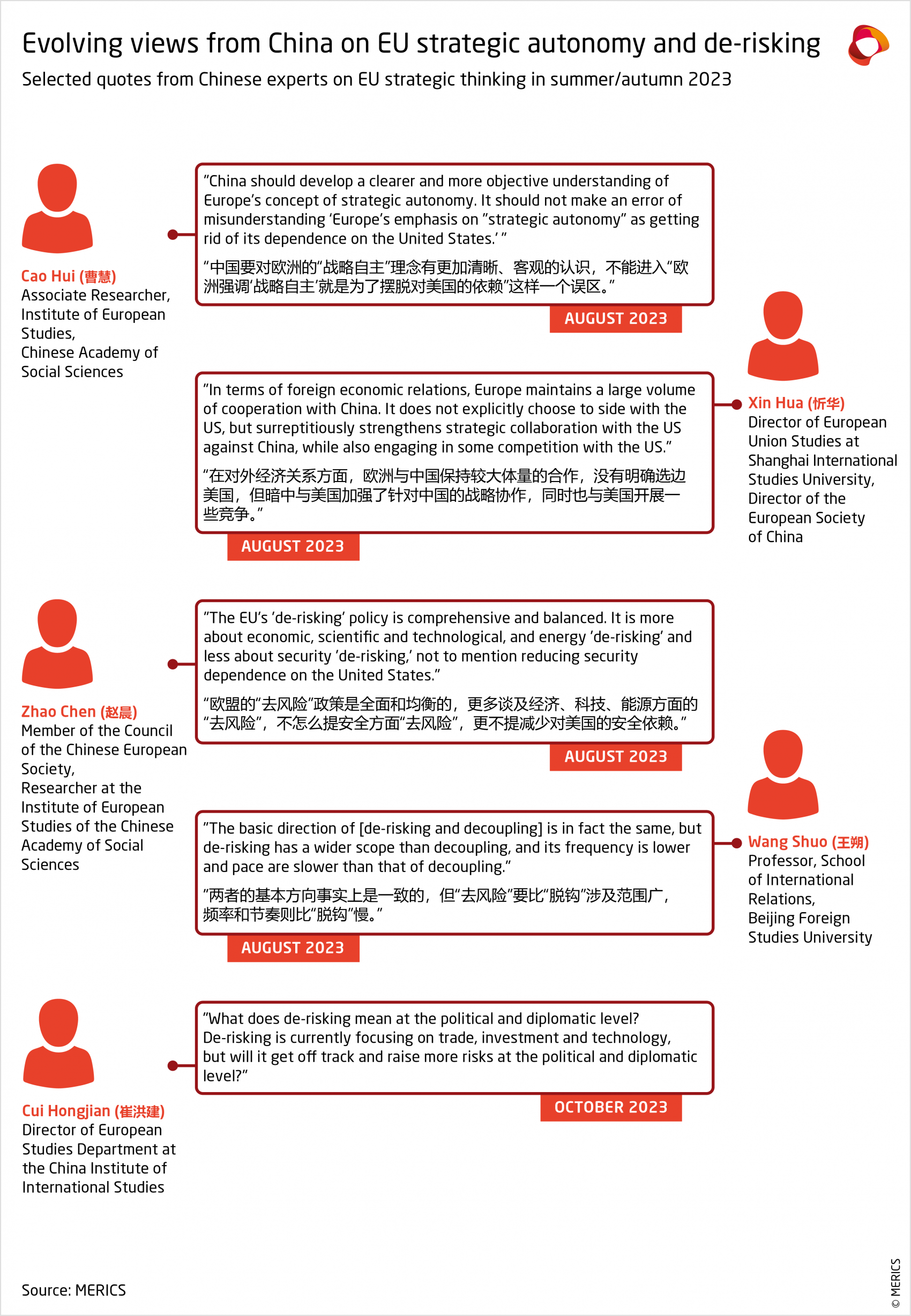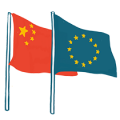

EU risk assessment + Borrell and Wang dialogue + Chinese views on EU's strategic ambitions
Analysis
Assessing risky business: EU to risk assess critical technologies
Of the ten critical technologies identified by the European Commission, advanced semiconductors, artificial intelligence, quantum computing, and biotechnologies are the four selected to undergo a risk assessment, as announced on October 3.
The European Commission and European External Action Service presented the EU’s economic security strategy in June 2023, which introduced “a framework for a robust assessment and management of risks to economic security at EU, national and business level while preserving and increasing our economic dynamism.” As the 2024 European elections approach, a potential shift in the Commission leadership is on the horizon, which means the implementation of the economic security strategy – along with new policies, fine tuning of old ones and the risk assessment – have been fast-tracked to the last quarter of 2023.
The strategy presented a three-pillared framework of “protect, promote and partnership” and a series of policies within each pillar. The “protect” pillar is where the EU has been making tangible progress and where most of the changes will occur this autumn.
An expansion of the list of items of “annex I” of the 2021 EU regulation of export controls is to be expected not only as a result of the risk assessment but also as result of a growing number of member states that follow the Dutch approach of expanding the national list of items subject to export controls.
It is not entirely clear if the list of critical technologies and the following risk assessment will have an impact on the review of the EU’s inbound investment screening regulation, but considering the EU was in search for a holistic approach, it is not unlikely. In fact, the list and assessment will provide the basis for discussion of a potential screening of outbound investments that should happen by the end of the year.
Setting it apart, the European Commission has initiated a case against Chinese electric vehicles based on the anti-subsidy element of the EU's trade defense instruments (TDIs). Resulting from neither the list of critical technologies, nor the risk assessment, the case seems to be a renewed effort deriving from a more traditional set of instruments that seek to level the playing field with China and prevent market distortions. This is particularly notable as neither list includes technologies essential for the green transition.
The risk assessment will dictate the development of many of the economic security policies as – in theory – it should highlight areas where the risk to EU economic security is currently satisfactory, requires expansion of existing policies (i.e., export controls) or potentially a rethinking and re-sizing of what the EU has already detailed.
The risk assessment is likely to indirectly show that China is a core concern when it comes to all four of the risks identified by the economic security strategy: risks to the resilience of supply chains, risks to physical and cyber security of critical infrastructure, risks related to technology security and technology leakage, and risks of weaponization of economic dependencies or economic coercion.
Focusing policies directly on China might seem easier than undergoing a lengthy risk assessment. However, there are three main reasons why this is likely not the best approach.
First, with regard to future-proofing the implementation of the EU’s economic security strategy, China is likely to remain a main area of concern. Although, much like the anti-coercion instrument originating out of concerns related to the US Trump administration and consequently pivoting focus to China, policies born out of concerns linked to China can be applied to other actors if they threaten the EU’s economic security.
Second, targeting China explicitly would face opposition and a lack of buy-in from member states. The implementation of most economic security policies lays with member states and as such, implementation proving already difficult as it is – could evolve into a China issue and implementation would ultimately become that much more difficult with little to no advantages.
Finally, the beauty of a risk assessment is that it can unveil risks that had not been identified before, therefore uncover the need for action, but it can also show that risks that were thought to be large and likely to occur are instead quite manageable – mostly regarding the bilateral relationship with China.
Economic security will continue to occupy an important role in the EU–China agenda this autumn, and the risk assessment may provide just the right basis for balancing the EU’s position. Risk assessments are not an exact science, but being able to communicate EU concerns on the basis of an assessment rather than geopolitical competition may lead to a long sought after increased unity in the EU’s position towards China.
Read more:
- European Commission: Commission recommends carrying out risk assessments on four critical technology areas: advanced semiconductors, artificial intelligence, quantum, biotechnologies
- European Commission: Commission Recommendation of 03 October 2023 on critical technology areas for the EU's economic security for further risk assessment with Member States
- CSIS: Current EU Regulations Struggle to Adapt to a Post-October 7 World
- South China Morning Post: In focusing on China, Europe risks missing true ‘de-risking’ dangers
Update
Borrell and Wang dialogue – An EU–China summit aperitif
Third time's a charm! After two unsuccessful attempts to visit China earlier this year, the EU's High-Representative Josep Borrell travelled to Shanghai and Beijing from October 12–14. The focal point of the visit was the High-level Strategic Dialogue between Borrell and Wang Yi, laying the groundwork for the upcoming end-of-year EU–China summit.
What you need to know:
- Schrödinger’s counterpart: Despite initial hopes for robust discussions on geopolitical security and military affairs, Borrell’s agenda had to be streamlined over the disappearance of China’s Defense Minister Li Shangfu.
- On cooperation & de-risking: Borrell aimed to reframe EU–China engagement to create opportunities for targeted cooperation despite ongoing tensions. On the one hand, he insisted that the EU’s de-risking is an actor agnostic resilience building exercise, not targeting China, while on the other, pointed out China’s legacy of its own de-risking-like policies, doubling of trade deficit between the EU and China over the last two years and Beijing’s tendency to overly regard its relations with Europe through the lens of US–China competition.
- Wang’s take: Beijing’s message was in turn more in line with traditional rhetoric claiming that the EU and China are “partners first, consensus far outweighs differences” (首先是伙伴,共识远大于分歧). Wang indicated that amid the increasingly chaotic international situation the EU and China need to improve the understanding of each other’s strategic positioning, while sticking to the mantra that the two sides have no major conflicts of interest.
- Geopolitical picture: There are no signs of constructive discussions between the two partners on topics such as visions of multilateralism or positions towards tensions in the Taiwan Strait or towards Russia’s invasion of Ukraine, with the EU renewing a call for Beijing to push Moscow to return to the Black Sea grain agreement. The two do both support a two-state solution to the Israel-Palestine conflict, but do not indicate appetite for coordinated actions (with China exploring that path with Moscow).
Quick take: Although the recent dialogue did not yield significant outcomes, it set the stage for the anticipated EU–China summit in Beijing later this year. Both the date and the agenda are yet to be decided, but the EU seems to be developing a new approach to engaging China; balancing between more plainly stating their differences and desired measures to address related challenges while acknowledging the points of common interest.
For this more realistic approach to the relationship to work, Beijing will need to reciprocate by shifting away from unrealistic “win-win” narratives and tempering the anti-American agenda within its relationship with the EU (certain Chinese think-tank sphere signals discussed below suggest internal discussions happening in China to that effect).
This series of high-level dialogues between the EU and China offers a higher chance to lock in some concrete, targeted cooperation actions. However, they also signal that while re-engagement between the EU and China is taking shape, it is not likely to be a reopening and revitalization of the relationship.
Read more:
China Debates: Evolving views on Europe’s strategic ambitions
Recently, Chinese think tanks have revitalized their interactions with European counterparts by inviting European experts to events in China and by making visits to Europe. As the EU and China were preparing for a flurry of high-level dialogues, Chinese MFA-controlled World Affairs (世界知识) published a reflection on Europe’s strategic autonomy by several think tankers offering more nuanced interpretations of Europe’s strategic direction.
What you need to know:
- Brussels Bustle: Several Chinese think tanks have recently visited Brussels for a set of track 1.5 and track 2 exchanges including: Center for China and Globalization, China Institute of International Studies, China Institutes of Contemporary International Relations, Chinese Academy of Social Sciences.
- Anti-American oldies: Chinese think tankers used to frame Europe’s strategic autonomy solely as an ambition to prevent a “state of total dependence on the United States” (对美国的全面依赖状态) which supposedly created incentives to seek a counterbalance by engaging Beijing. Last March, the prevailing narrative still highlighted Europe’s strategy as grappling with “two contradictions” stemming from Russia’s war in Ukraine. The growing interest in enhancing strategic capacities, maintained Chinese analysts, was accompanied by increasing security dependence on the US paired with a transatlantic “economic shadow war” that further hindered the EU’s ability to limit reliance on Washington. (See past analyses linked below)
- Adjusted take: The new interpretations are more nuanced and come with the need for China to update its thinking on Europe’s strategic concepts, moving away from narrow, US-centered interpretations. Consensus among the featured analysts seems to be that the EU’s strategic autonomy has taken shape as embracing strategic security (战略安全) and defense through cooperation with the US and like-minded partners, all the while seeking to bolster overall economic and technological sovereignty (经济主权/技术主权).
- De-risking musing: The de-risking concept is seen as an extension of those ambitions and one focused on addressing economic, tech and energy challenges. Yet, the political or diplomatic aspects of de-risking (mentioned by President von der Leyen in her speech in March) remain elusive for Chinese experts, as is the ultimate implication of the EU’s de-risking trajectory, with some Chinese analysts raising questions about whether it does not simply amount to a gradual decoupling.
Quick take:
The update in thinking on European strategy likely is a result of new points of view at the top that facilitated those at the bottom. The greater interest of the Beijing leadership in understanding and stabilizing relations with Europe are its own domestic economic hurdles which has led to a re-opening of direct exchanges, helping Chinese think tankers get a better sense of the situation on the ground.
It remains to be seen, however, whether during the new wave of interactions, Chinese actors will have greater opportunities for in-depth and less constrained exchanges. For now, it appears that Beijing is eager to reactivate think tank exchanges to learn more about the positions of its partners, but continues to constrain Chinese actors to only amplify official messages abroad.
Read more:
- World Affairs (世界知识) [CN]: Europe is "rethinking"
- Global Times: Borrell's trip conducive to the healthy, stable devt of China-EU ties
- MERICS: China Debates: EU’s geopolitical standing and EU-China relations in the second year of Russia’s war against Ukraine
- MERICS: How China views the EU amid the Russia-Ukraine war: Contradictions of transatlantic relations and strategic autonomy
- MERICS: “Correct choice” on strategic autonomy: What China wants from the EU
Short takes
EU–US contemplating deal on China steel
During the upcoming EU–US summit on October 20, Brussels may announce a new anti-subsidy investigation into steel-producing countries suspected of excessive production, including China. The move would be a part of discussions with Washington to end Trump-era tariffs on European steel and aluminum and geared towards countering steel production overcapacity globally.
- Politico: It’s the EU and US against the rest of the world in new steel club
- Reuters: China warns EU steel probe will push up costs
Energy Commissioner Kardi Simson visits China
Simson visited China between October 11–13 and conducted the first in-person high-level energy dialogue with China's National Energy Administration chief Zhang Jianhua since 2019. The pair discussed increasing renewable and methane reduction targets in the context of the COP28 meeting in Abu Dhabi in late November, but Simson has not publicly called out Beijing’s lowering of carbon-emission-cutting targets.
- European Commission: Commissioner Simson travels to Beijing to co-chair EU-China High-Level Energy Dialogue
- SCMP: China, EU ‘can play great part’ in climate battle, bloc energy chief Kadri Simson says in call to join methane pledge
Orbán the only EU leader to join third Belt and Road Forum
The Forum, took place in Beijing between October 17–18, marking the BRI’s 10th anniversary. Hungarian Prime Minister Viktor Orbán met with President Xi Jinping raising the issue of their flagship Budapest-Belgrade railway project – works of which were suspended over Chinese contractors’ failure to meet safety standards and with Russian President Vladimir Putin on the Forum sidelines.
In 2019, during the second edition of the forum, leaders of Austria, Cyprus, Czech Republic, Greece, Hungary, Italy and Portugal were all there, now though, only Orbán is making the trip.
- Telex: Viktor Orbán to speak at Belt and Road Forum in Beijing, where Putin will also be attending
- Reuters: China's Xi says he considers Hungary's Orban a 'friend'
- MFA of the PRC: Xi Jinping Meets with Hungarian Prime Minister Viktor Orbán
Belgian intelligence investigates Alibaba hub in Liège
Opened under a 2018 agreement with Belgium, the Alibaba-owned and subsidiary-operated airport and rail hub is its main logistic center in Europe. Following the introduction of new regulations on screening foreign investment in critical infrastructure in July, Belgian authorities will review the subsidiary activity of Cainiao. Particular focus is put on software systems that can gather data offering insights into European supply chains, related vulnerabilities and local sentiments. The fear is that under China’s National Intelligence Law, Cainiao may be forced to share the data with Chinese authorities.
- FT: Alibaba accused of ‘possible espionage’ at European hub
- The Guardian: Belgian intelligence investigating logistics hub of China’s Alibaba at local airport
European Parliament pushes for ban on forced labor
On October 16, the international trade and internal market and consumer protection committees of the European Parliament adopted their position on anti-forced labor regulations, which has frequently been referenced in the context of China, in particular, ethnic minorities of the Xinjiang region. The file now moves towards a “trilogue” between the Parliament, European Commission and the Council of the EU with the ambition to agree on and implement the legislation by the end of the Parliament’s mandate next year.
- European Parliament: Towards an EU ban on products made with forced labour



